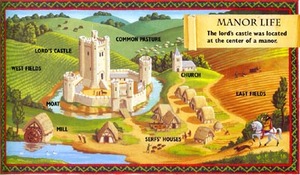The age of feudalism, more commonly known as the middle ages, was a time when the lords controlled manors and were the powers of Europe. The age of feudalism was the era in which there was no central government and land was controlled by lords and nobles.
The middle ages can be characterized as the age of feudalism because it was a time when there was no economy and no central government. The way of life for people was based on the feudal system which was when people exchanged services in a system where obligations bound lords and their subjects together.
In the middle ages, kings would grant fiefs to lords in return the lords would pledge their loyalty to their kings, as described in document four. A fief is a large plot of land also known as a manor which serfs worked on and farmed. In return for their labor, the lords promised protection to serfs. The feudal system could be considered the government of the middle ages.
In this system, people were given authority based on their social class. In “document two”, it talks about how people were not characterized by their wealth only because there was no money system at the time. At the top of the social pyramid were the kings and the lords. Although the kings gave out land to the lords, the lords still had power because they controlled the vassals which were next in line. Under the vassals are the knights, which weren’t required to work in the fields and farm like the serfs, but pledged their loyalty and their military services to their vassal . On the same social level as the knights were the craftsmen. Craftsmen didn’t work in fields, but had skills of other trades, such as a blacksmith. As shown in the article “The End Of Europe’s Middle Ages”, the Lords gave the knights a place to sleep, and food to eat. The lowest level on the social pyramid were the serfs who menial labor, but without who the manor would not survive.
The land of the manor was divided according to social classes. All the serfs lived near the fields and farms. They usually lived in lower elevation areas. This was because if there was ever an attack, the serfs would be first to die. They would almost serve as a barrier, holding off the invaders from reaching the castle which would give the knights time to asses the situation, as seen in the article “Rural Society” from the book Atlas of Medievil Europe. The castle was built at the highest point of the manor this is were the lords lived. Having the castle at the highest elevation is strategic because whenever intruders attacked and approached the castle, the archers had the advantage of shooting down at the enemy while the enemy had to run up a hill. The knights’ homes were spread out across the land for different reasons. One reason was because the knights did not want to live with the serfs at the low elevation. It was difficult to build homes on a hill, therefore knights’ homes were spread throughout the manor wherever flat land was available. This turned out to be beneficial because when attacked there was protection all around the castle. In the middle of the social and land segregation was the church where everyone came together to pray.
The middle ages was a time that should be known as the age of feudalism. Feudalism was the government, the economy, and the way of life for people living in the middle ages. Without the knights loyalty and protection of the manor, the feudal system would fail. Without the serfs’ hard work and farming, the feudal system would fail. With out the lords’ leadership and organization the feudal system would fail Everybody that lived on a manor contributed to its success. All levels of the social pyramid were significant and were needed for the exchange of their individual skills and talents.

